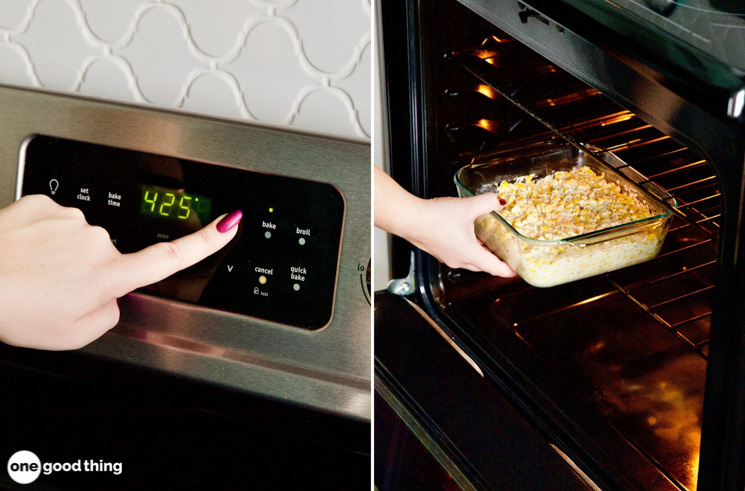
From casserole dishes to pie plates and beyond, I have several trusty Pyrex dishes in my kitchen that have served me well for many years! Glass has several advantages that have one of the most popular materials for cookware and bakeware for decades, including being easy to clean, heating evenly, and showing us exactly how our food is cooking.
But what is Pyrex, exactly? Pyrex is a brand name (like “Kleenex” for tissues) for a special type of heat safe glass that was developed by Corning Glassware Company all the way back in 1915 called borosilicate glass. The name came from components that were used to make the glass, and although Corning has stopped using borosilicate glass in favor of soda lime glass that’s cheaper to produce, the original name lived on.
Whether you have a big collection of vintage Pyrex or a few pieces of glass cookware that are relatively new, you may have wondered at some point whether Pyrex is oven safe. The answer is a bit more complicated than it might sound, so I thought we’d explore the question and answer thoroughly in today’s post!
Looking for tips about cleaning Pyrex? Check out this post!

Is Pyrex Oven Safe?
The short answer to this question is “yes!” Pyrex bakeware (both old and new) is safe to use in your oven – and microwave – as long as you avoid dramatic, sudden temperature changes. But as with almost any type of glass item, there are few finer details worth knowing in order to use it safely and effectively.

Why It’s Important To Avoid Sudden Temperature Changes
As I mentioned earlier, modern Pyrex is made of soda lime glass, and this type of glass can tolerate both hot and cold conditions well. However, it’s not quite as resistant to thermal shock as the old borosilicate glass, meaning it cannot tolerate sudden exposure to a dramatically different temperature.
Sudden temperature changes are the enemy of glass, and that includes Pyrex glass. There are plenty of anecdotes and horror stories you can read online about Pyrex glassware cracking, shattering, or even exploding, but almost every instance is tied to sudden changes in temperature that compromised the integrity of the glass.
While some temperature change scenarios are more obvious (such as taking a Pyrex baking dish out of the fridge and putting it into a hot oven), some are less easy to identify. For example, it can be equally unsafe to take hot glassware out of the oven and set it on a wet countertop. (That’s because the thin layer of water on the countertop is cool, and thus likely to lead to the type of thermal shock that can shatter Pyrex.)

5 Tips For Using Pyrex Glassware Safely
In addition to avoiding the two temperature change scenarios I just mentioned, here are a few other guidelines that will help you use your Pyrex dishes safely!
1. Always Preheat Your Oven First
Pyrex is oven safe as long as you preheat the oven before putting it in. (This might sound counterintuitive, but according to usage instructions on the Pyrex website, the direct heat during preheating can lead to breakage.)
2. Avoid Your Stovetop
Pyrex is oven safe and microwave safe, but it isn’t designed for other types of cooking or for use on a direct heat source. Do not use Pyrex on your stovetop (gas or electric), under the broiler, in a toaster oven, or on a grill.
3. Be Careful With Liquid
If you’re using Pyrex to cook something that may release liquid (including fat, juices, or moisture from frozen foods), add a small amount of liquid to cover the bottom of the dish before you put it in the oven. This will minimize the effects of any change in temperature from the liquid that gets released from the food during cooking.
Also, don’t add liquid to hot Pyrex or handle hot glassware with wet oven mitts or potholders. Even a room temperature liquid can be too much of a temperature change for hot glass, and it could lead to cracking or breaking.
4. Set It On Cloth Or Wood
When you take a hot Pyrex dish out of your oven, be sure to set it down on something safe, like a kitchen towel, a dry cloth potholder, a wooden trivet, or a cooling rack. Don’t place hot Pyrex directly on the counter, or on a wet, metal, or cool surface of any kind, all of which can lead to thermal shock.
5. Let It Come To Room Temperature
Whether you want to store dinner leftovers in the fridge or bake something that has been chilling, always allow time for a glass pan come to room temperature before exposing it to a hotter/colder environment, or before immersing it in water. It may take more time, but that’s the point—a slow temperature change is a safe one (and it’s better than cleaning up a bunch of shards of glass!)

The Takeaway
In case you haven’t heard it enough, the key takeaway of all this is to be gentle when it comes to heating and cooling your Pyrex. Shocking the glass with rapid changes in temperature can lead to cracking or breaking, and no one wants that!
Make sure that the oven mitts, cloths, and trivets you use to handle hot Pyrex dishes are completely dry. And if you ever notice any cracks in your Pyrex dishes (even if they are tiny or don’t go all the way through), stop using that dish in your oven. High temperatures can cause cracks to expand very suddenly, even long after the initial crack forms.
Do you have any Pyrex dishes at home?
No comments:
Post a Comment